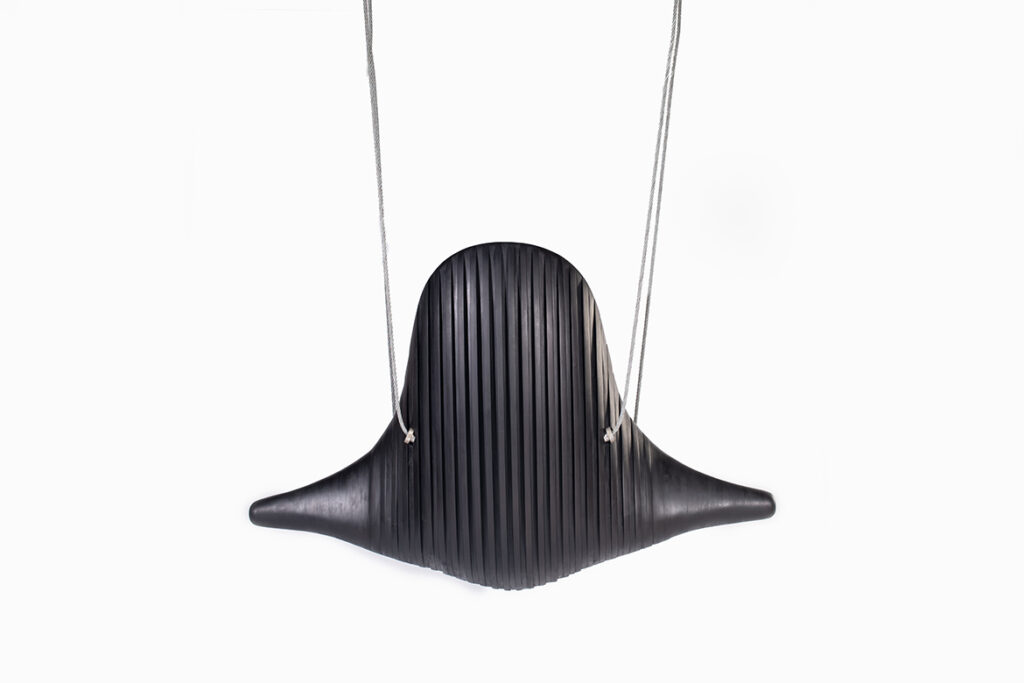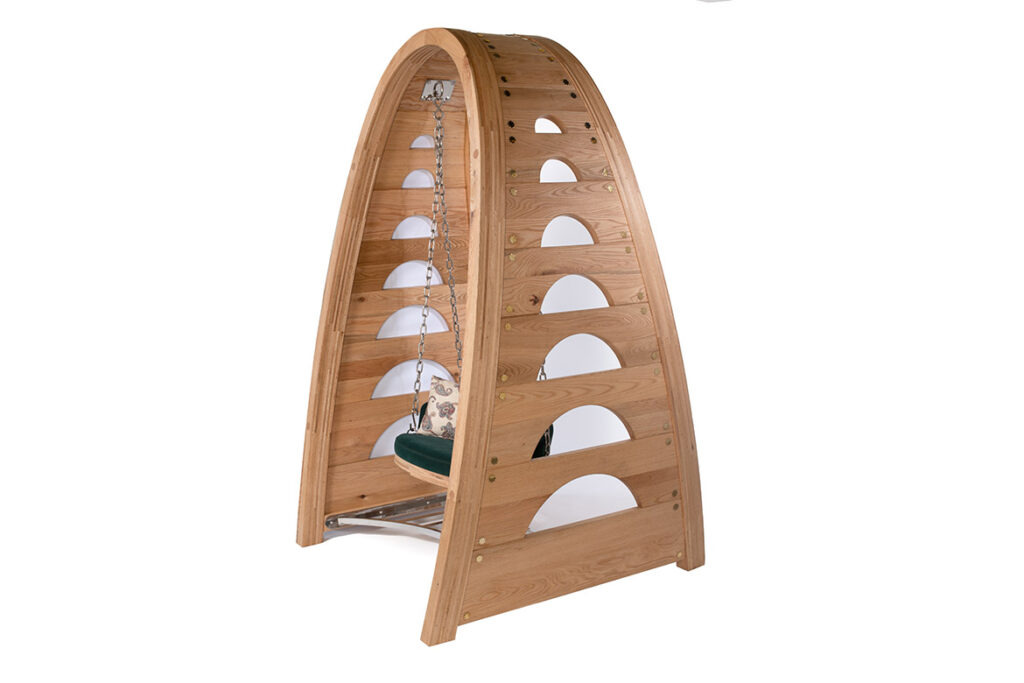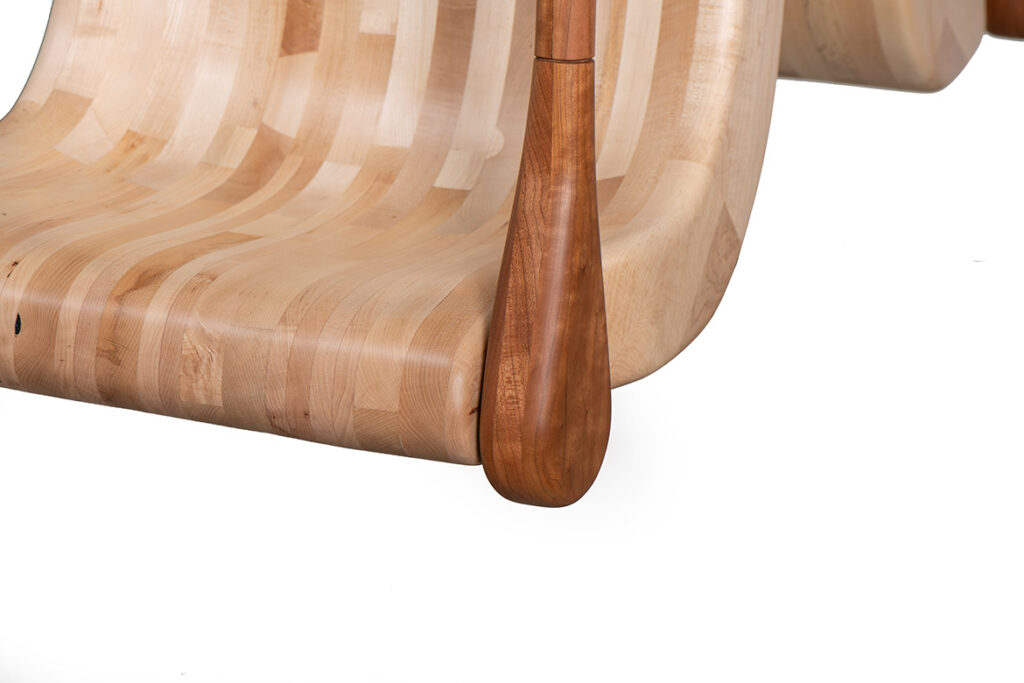Annkur Khosla, Naresh V Narasimhan, Prem Nath, Sanjay Puri, and Sonali and Manit Rastogi reinterpret the traditional Indian swing seat in collaboration with AHEC and THINK! Design.

September 7th, 2023
The jhoola has been a part of Indian homes for generations, providing comfort and relaxation to its users. The traditional Indian swing seat, often suspended from ropes or chains, has been reinterpreted by five established Indian architects using American hardwoods in a meaningful project called REIMAGINE, orchestrated by the American Hardwood Export Council (AHEC) in partnership with THINK! Design.
The project stands as AHEC’s most ambitious design collaboration in India. Prominent names such as Annkur Khosla, Naresh V Narasimhan, Prem Nath, Sanjay Puri and Sonali & Manit Rastogi were put to the challenge, resulting in avant-garde designs that draw from their nostalgic memories. Debuted at INDEX Mumbai 2023, the collective designs also considered the environmental impact and human well-being.
Skilfully utilising American cherry, maple and red oak, the swings were expertly crafted by Bram Woodcrafting Studio in Mysore. Guiding this creative endeavour was mentor Adam Markowitz from Melbourne, contributing his expertise to this remarkable fusion of tradition and innovation. Below are further details of each exceptional design.
Annkur Khosla drew inspiration for her design from the intricate art of weaving, delving into the interplay of warp and weft threads. Recognising that traditional woodworking doesn’t inherently follow this woven process, her goal was to break free from these constraints. Simultaneously, she aimed to challenge the material’s boundaries and elevate the possibilities of woodworking to new horizons.


Sanjay Puri’s jhoola embodies a dual essence, seamlessly blending the monolithic and the fluid. The seat, armrests, and back harmoniously converge, crafting a sculptural masterpiece. Beyond its functional role as a swing, this design transcends into an artistic creation, captivating the eye with its visual allure.


Naresh V Narasimhan’s jhoola takes inspiration from the iconic Veena instrument featured in Hindola Raga art. Historically, swings were symbols of luxury, gracing royal gardens and verandas in Indian culture. Ragamala paintings, depicting musical modes, historically showcased swings in royal settings. Naresh’s design incorporates movement, rhythm, and asymmetry from these paintings, offering a dynamic seating experience. It aims to evoke feelings of fun, relaxation, and playfulness, echoing the versatility of swings in historical contexts.


Prem Nath envisions the jhoola as an embodiment of outdoor playfulness, where strings and planks sway from tree branches or grace interior spaces as ornate furniture. Reflecting prosperity and comfort in Indian homes, his design preserves the swing’s traditional essence in contrast to new generation homes, which lean towards contemporary aesthetics. His creation combines neo-classical elements with subtle Indian embellishments, harmonising tradition with minimalist elegance.


Sonali and Manit Rastogi’s design is a poignant response to the transformed communication landscape brought about by the COVID-19 pandemic. It centres on facilitating safe reconnections among friends and close companions through a thoughtfully designed jhoola. Balancing comfort and aesthetics, it offers a secure space for distanced conversations while doubling as an eye-catching art piece when not in use.


A searchable and comprehensive guide for specifying leading products and their suppliers
Keep up to date with the latest and greatest from our industry BFF's!

‘The Elevation of Gravity’ installation was an immersive showcase of innovation that heralded the debut of Gaggenau’s groundbreaking Essential Induction cooktop.

Marylou Cafaro’s first trendjournal sparked a powerful, decades-long movement in joinery designs and finishes which eventually saw Australian design develop its independence and characteristic style. Now, polytec offers all-new insights into the future of Australian design.

The Sub-Zero Wolf showrooms in Sydney and Melbourne provide a creative experience unlike any other. Now showcasing all-new product ranges, the showrooms present a unique perspective on the future of kitchens, homes and lifestyles.

Savage Design’s approach to understanding the relationship between design concepts and user experience, particularly with metalwork, transcends traditional boundaries, blending timeless craftsmanship with digital innovation to create enduring elegance in objects, furnishings, and door furniture.

The American Hardwood Export Council promotes the works of next-gen designers through Discovered Singapore exhibition happening from 16 to 22 May at Red Dot Design Museum Singapore.

As one of the many entries to The Building category at the 2024 INDE.Awards, this community centre is something out of the ordinary through its architectural design, that also provides a place for community and connection for many.

American Hardwoods are known for their unmatched beauty, diversity of species and sustainability. Here we take a look at some of the most significant projects that have paved the way for the ongoing success of American hardwoods in Australian design.
The internet never sleeps! Here's the stuff you might have missed

What’s in a name? At Wardle, a new name marks the next progression in the architecturally designed road for this outstanding practice.

An entry by MuseLAB, in The Retail Space in the 2024 INDE.Awards, takes shoppers to another planet where diamonds and great interior design make a lasting impression.

Welcome to the year of the Design Effect. This year’s theme aims to showcase the profound ripple effects that exceptional design can have on people, place and planet. Join in shaping this narrative by contributing your perspective before May 3, 2024, and become a part of the Design Effect movement.